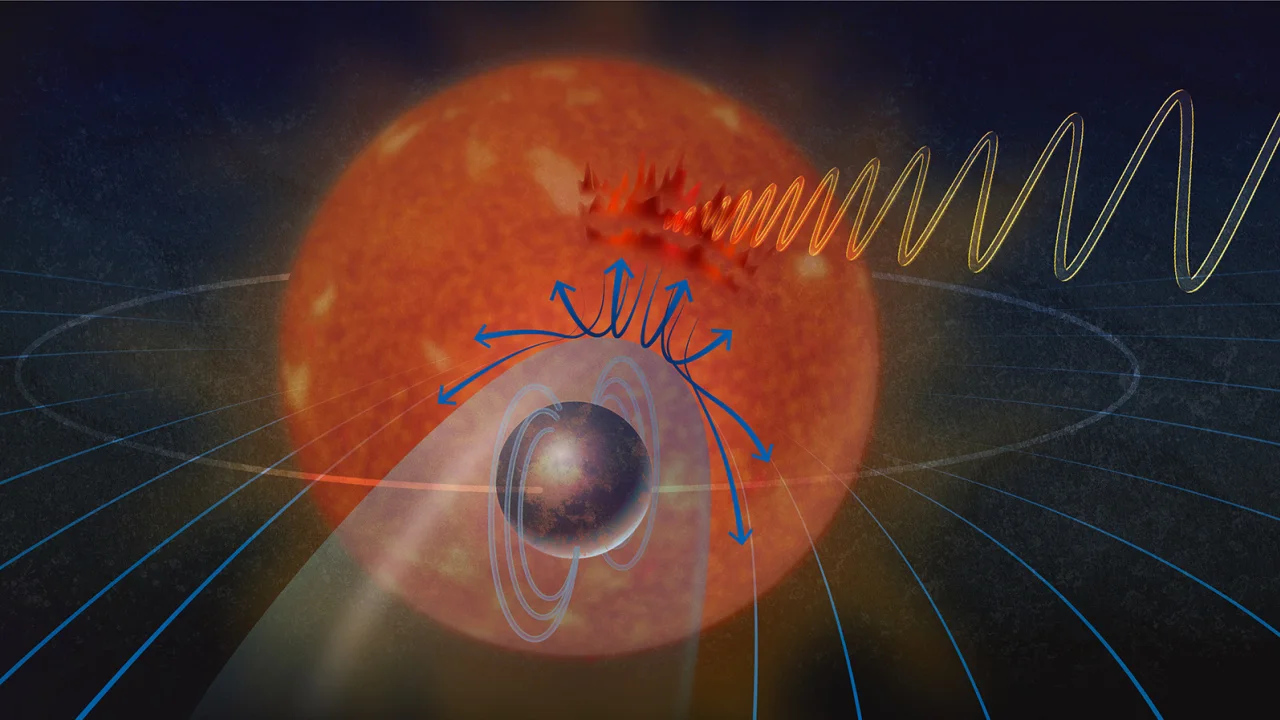(CNN) — Astronomers have detected a repeating radio signal from an exoplanet and its orbiting star 12 light-years from Earth. The signal suggests that an Earth-sized planet may have a magnetic field and even an atmosphere.
Earth’s magnetic field protects the planet’s atmosphere, which life needs to survive, by deflecting energetic particles and plasma from the Sun. Finding atmospheres on planets outside our solar system may indicate the existence of other worlds capable of supporting life.
Carl G. in New Mexico. Observing with the Jansky Very Large Array Telescope, scientists detected strong radio waves coming from the star YZ Ceti and a rocky exoplanet known as YZ Ceti b orbiting it. Researchers believe the radio signal is created by interactions between the planet’s magnetic field and the star.
magazine Natural Astronomy released a study on Monday detailing the findings.
“We saw the initial burst and we thought it was beautiful,” says Sebastian Pineda, lead author of the study and a research astrophysicist at the University of Colorado at Boulder. “When we looked at it again, it was a great sign that, OK, maybe we really do have something.”
Magnetic fields can prevent a planet’s atmosphere from being depleted and eroded fundamentally over time as particles break away from the star and bombard it, Pineda said.
How intense radio waves are generated
According to the researchers, for radio waves to be detected on Earth, they must be very intense. “Whether or not a planet has an atmosphere depends on whether or not the planet has a strong magnetic field,” Pineda said.
Previously, researchers have detected magnetic fields similar to those of Jupiter, the largest planet in our solar system. But magnetic fields are more difficult to detect on small planets like Earth because they are invisible.
“What we’re doing is looking for a way to see them,” said co-author Jackie Willettson, associate professor of physics and astronomy at Bucknell University in Pennsylvania.
“We’re looking for planets that are very close to their stars and about the size of Earth,” he explains. “These planets are very close to their stars for habitation, but being so close, the planet passes through a lot of material coming out of the star. If the planet has a magnetic field, it passes through enough of the star’s material, which causes the star to emit bright radio waves.”
YZ Ceti b takes two Earth days to complete a single orbit around its star. Meanwhile, the shortest orbit in our solar system is the orbit of Mercury, which takes 88 Earth days to complete one revolution around the Sun.
As YZ Ceti b orbits its star, the plasma collides with the planet’s magnetic field, bounces back, and interacts with the star’s magnetic field. All of these energetic reactions generate and emit strong radio waves that can be detected on Earth.
This illustration shows plasma emitted by a star being deflected by the magnetic field of an exoplanet orbiting it. The plasma then interacts with the star’s magnetic field, creating auroras and radio waves. (Credit: Alice Kitterman/National Science Foundation)
The researchers measured the detected radio waves to determine the strength of the planet’s magnetic field. “This gives new information about the environment around stars,” says Pineda. “We call this idea ‘outer space weather.'”
In our solar system, the sun’s activity can create space weather that affects Earth. Energetic bursts from the Sun can disrupt satellites and global communications and cause dazzling light displays near the Earth’s poles, such as the aurora borealis.
Scientists hypothesize that interactions between YZ Ceti and its planet also create an aurora, but this light show takes place in the star itself. “We’re actually seeing an aurora in the star, which is this radio emission,” Pineda said. “If the planet has its own atmosphere then it must have an aurora.”
Best candidate
Researchers believe YZ Ceti b is the best candidate ever discovered for a rocky exoplanet with a magnetic field. “It’s very possible,” says Willetsen. “But I think it will take a lot of follow-up work before we can confirm that the radio waves are caused by a planet.”
New radio telescopes scheduled to go online this decade could help astronomers further detect signals suggestive of magnetic fields, the researchers said.
“The search for habitable or life-supporting worlds in other solar systems depends on being able to determine whether rocky, Earth-like exoplanets actually have magnetic fields,” said Joe Bess, program director at the National Radio Astronomy Observatory. A statement.. “This research shows that this particular rocky exoplanet may have a magnetic field, but provides a promising method for further discovery.”





